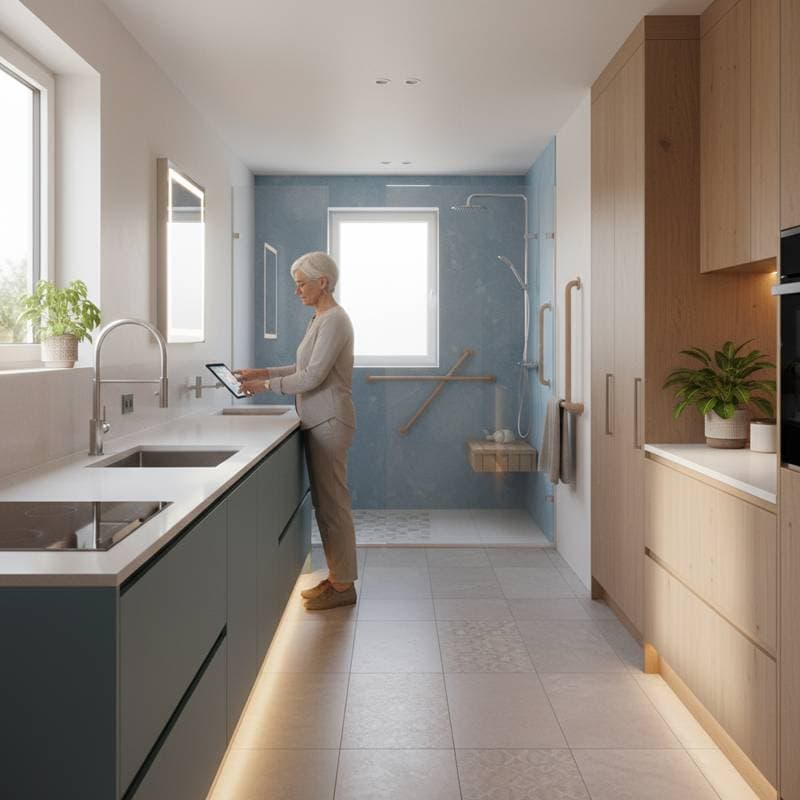Aging in Place Remodel Costs: $9,000 to $75,000 in 2025
Aging in place allows individuals to maintain independence within their homes as they grow older. Home modifications enhance safety and accessibility, enabling residents to navigate spaces comfortably without relocation. These remodels range widely in scope and expense, from simple updates to comprehensive overhauls, with costs typically falling between $9,000 and $75,000 in 2025.
Understanding these investments requires examining average prices, influencing factors, and planning strategies. This guide provides detailed insights to help homeowners make informed decisions that prioritize long-term well-being and financial prudence.
Understanding Aging in Place Remodels
Aging in place remodels focus on adapting living environments to accommodate mobility challenges, health needs, and daily routines. Common features include wider doorways, grab bars, and non-slip flooring to prevent falls and support autonomy.
These projects differ from standard renovations by emphasizing functionality over aesthetics. Homeowners often integrate universal design principles, which benefit all ages while specifically addressing senior requirements. The result is a residence that evolves with its occupants, reducing the need for future institutional care.
Average Cost Breakdown for 2025
Costs for aging in place remodels vary based on project scale and location. Basic updates, such as installing handrails and lever handles, start at $9,000. These minimal interventions target high-risk areas like bathrooms and entryways.
Mid-range projects, involving kitchen adaptations and stair modifications, average $25,000 to $45,000. Full-home transformations, including ramp installations and smart home integrations, reach up to $75,000. Regional labor rates and material prices influence these figures, with urban areas commanding higher premiums.
- Bathroom Modifications: $5,000 to $15,000, covering walk-in showers and raised toilets.
- Kitchen Updates: $10,000 to $25,000, featuring pull-out shelves and lowered counters.
- Entry and Mobility Enhancements: $3,000 to $10,000 for ramps and threshold adjustments.
- Whole-Home Accessibility: $40,000 to $75,000, incorporating elevators or platform lifts.
These estimates account for 2025 inflation trends, with a projected 3-5% increase over prior years due to rising material costs.
Key Factors Influencing Costs
Several elements determine the final price of an aging in place remodel. Home size and layout play significant roles; older structures may require structural changes, escalating expenses.
Material choices also impact budgets. Durable, low-maintenance options like vinyl flooring or composite decking add upfront costs but yield savings over time through reduced upkeep.
Professional involvement is essential. Certified aging-in-place specialists ensure compliance with safety standards, though their expertise justifies fees ranging from $100 to $200 per hour.
- Location: Coastal or metropolitan regions face 20-30% higher costs due to supply chain demands.
- Scope of Work: Custom features, such as voice-activated lighting, increase complexity and price.
- Permits and Regulations: Local building codes may necessitate additional inspections, adding $500 to $2,000.
- Energy Efficiency Upgrades: Integrating insulation or solar elements can qualify for rebates, offsetting 10-15% of expenses.
Homeowners should obtain multiple quotes to compare value and timelines, ensuring alignment with personal needs.
Strategies to Manage and Reduce Costs
Planning ahead minimizes financial strain in aging in place projects. Start by assessing current home hazards through a professional evaluation, which costs $200 to $500 but identifies priorities.
Phased implementation spreads expenses over time. Begin with essential safety features before advancing to comfort enhancements, allowing budget adjustments as funds become available.
Explore financing options tailored to seniors. Home equity loans or government programs like Medicaid waivers provide accessible funding without depleting savings.
- Prioritize high-impact changes: Focus on bathrooms first, where 80% of home injuries occur.
- Seek energy rebates: Programs from utilities can reimburse up to $5,000 for efficient modifications.
- DIY where safe: Simple tasks like installing grab bars save $500 to $1,000, but leave complex work to experts.
- Negotiate with contractors: Bulk purchasing materials or off-season scheduling reduces labor by 10-15%.
These approaches not only control costs but also enhance project efficiency.
Return on Investment and Long-Term Benefits
Investing in aging in place remodels delivers substantial returns. Enhanced home value increases resale potential by 5-10%, appealing to buyers seeking accessible properties.
Health improvements reduce medical expenses; fall prevention alone saves an average of $30,000 per incident in emergency care. Independent living preserves quality of life, delaying costly assisted care facilities that average $100,000 annually.
From a financial perspective, these modifications offer tax deductions under medical expense categories, potentially reclaiming 20-30% of costs. The emotional value of staying in familiar surroundings further amplifies the investment's worth.
Steps to Plan Your Remodel
Embark on your aging in place journey with a structured approach. First, consult a specialist to map out needs and draft a detailed plan.
Next, secure financing and select reputable contractors through verified references. Review contracts meticulously, specifying timelines and warranties.
During construction, maintain open communication to address issues promptly. Post-completion, evaluate the space and make minor adjustments for optimal use.
- Conduct a home assessment.
- Develop a prioritized budget.
- Hire certified professionals.
- Monitor progress and finalize payments.
This methodical process ensures a seamless transition to a safer, more comfortable home.
Achieving Comfortable, Independent Living
Aging in place remodels empower homeowners to age gracefully within cherished spaces. By balancing costs with essential upgrades, individuals secure safety, convenience, and value for years ahead.
These investments foster resilience against aging challenges, promoting sustained independence. Homeowners who plan thoughtfully experience not only physical benefits but also profound peace of mind.











